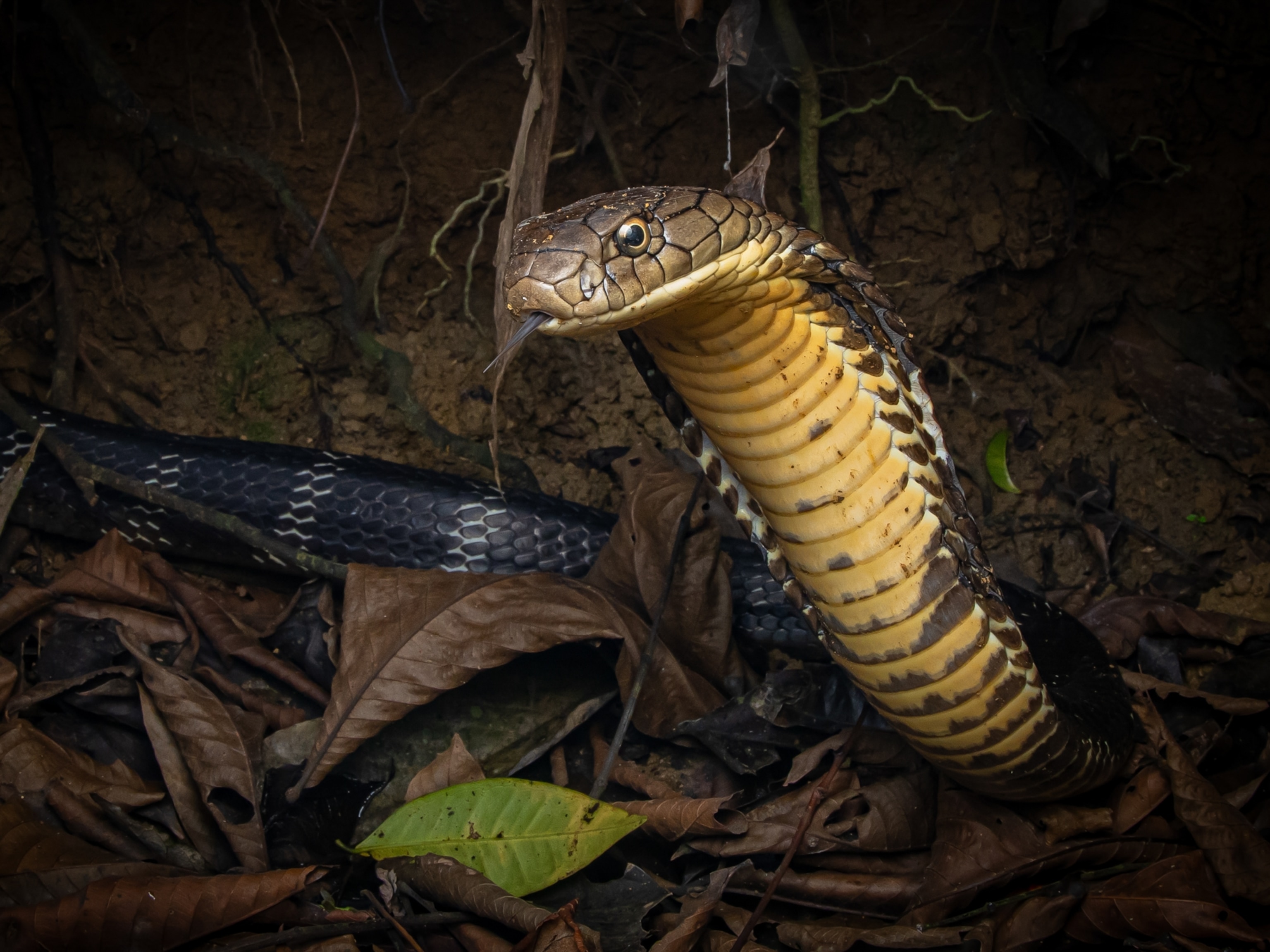The rattlesnake’s warning sound, a grating ch-ch-ch, is one of the most spine-tingling noises in nature—because if you can hear it, you’ve already wandered too close.
But according to a new study published August 19 in the journal Current Biology, that communication is more complex than anyone realized.
By analyzing the warning vibrations of western diamondback rattlesnakes (Crotalus atrox), scientists learned that the serpents rattle at lower frequencies of up to 40 hertz, or more slowly, when a threat is far away. But when an intruder gets too close for comfort—a distance that differs depending on the individual snake—the rattlers abruptly shifted to a faster, higher-frequency warning signal of between 60 and 100 hertz.
When test subjects were asked to listen and estimate how far away a rattlesnake in a virtual-reality grassland was, they guessed fairly accurately when the rattles were slower, or lower-frequency. When the rattles got faster, however, the humans were tricked into thinking the snakes were much closer than they actually were.
(Decapitated Snake Head Nearly Kills Man—Here’s How)
When a rattlesnake shakes its tail slowly, the human ear can perceive each individual rattle. But at higher frequencies, the individual sounds fuse into a continuous song, which sounds “completely different to our human ear,” says Boris Chagnaud, a neuroscientist at the University of Graz in Austria and senior author of the new study.
What’s more, through a quirk of perception, the high-frequency rattles sound louder to us even though they’re basically the same amplitude, or loudness, says Chagnaud.
“Maybe that’s another function of the rattling, is to kind of confuse predators,” says Bree Putman, a herpetologist at California State University, San Bernardino who was not involved in the study.

The secret language of rattling
More than 35 species of rattlesnakes live in the Americas, from southern Canada all the way to Argentina. When threatened, the snakes rapidly shake the tips of their tails like biological castanets, rattling interlocking sections of hollow keratin, the same stuff hair and fingernails are made of. (See pictures of rattlesnakes.)
While humans are just now clueing into the intricacies of rattlesnake communication, other species have been listening for the serpents’ rattle for much longer.
For instance, ground squirrels can use a rattlesnake’s rattling frequency to tell how dangerous the snake is.
This works because snakes are ectotherms, or cold-blooded. “Their performance is dependent on how warm they are,” says Putman. “So, a hotter snake is a more dangerous snake, and they rattle faster.”
Rattlesnakes vary their rattles for other reasons, as well. Pregnant rattlesnakes or those who have just given birth tend to be more aggressive, while those that are safely hidden below a rock or near a hole are less inclined to rattle. Some rattlesnakes are hard-pressed to rattle at all, relying instead on their expert camouflage to hide them from danger.
While it wasn’t surprising to Putman that the snakes would encode distance-related information in their tail-shakes, she found the fact that humans frequently misjudged the serpent’s distance intriguing.
Not for human ears
Rattlesnakes had been around for millions of years before humans are thought to have migrated to the Americas, so scientists believe the reptiles’ rattle evolved as a way to warn off other threats. In fact, some scientists believe the rattle originally might have been a way to keep bison from stepping on the camouflaged snakes.
“The most interesting aspect for a biologist like me is that we often hear other animals communicate, and we still don’t know most of the things that they are talking to each other about,” says Chagnaud.
Predators may be listening in on that communication, too. With a mouthful of venom capable of destroying skin and blood cells, it might be tempting to think that rattlesnakes are immune to predators altogether. But nothing could be further from the truth.
Scott Boback, an evolutionary ecologist at Dickinson College in Pennsylvania, uses remote cameras to study rattlesnakes as part of an experiment called Project RattleCam. He says he’s been shocked to see just how many creatures— from red-tailed hawks and magpies to raccoons and skunks—risk death to dine on the snakes.
“They do have to contend with lots of different animals,” says Boback of the survival challenge rattlesnakes face.
If so many predators like to eat rattlesnakes, then it’s quite possible that some animals may use a rattlesnake’s rattle not as a warning to stay away, but as a homing beacon leading to their next meal.
“I’m wondering whether the rattlesnakes are using that really high-frequency rattle, where the predator can’t really detect their distance, as more of a last-ditch [way to disappear],” says Boback.
What to do if you see a rattlesnake
Even for those who are used to seeing these animals in the wild, the ch-ch-ch of the rattlesnake’s maraca never gets old.
“That’s always kind of a heart-stopping moment,” says Asia Murphy, an ecologist at the University of California, Santa Cruz. “I love finding them, even though the sound scares me.”
Murphy frequently encounters rattlesnakes while studying their interactions with other predators, such as bobcats, foxes, and coyotes. She says there are a few easy rules for staying safe.
“Always keep track of where you’re sitting and where you’re putting your hands and your feet,” says Murphy. “Never try to actually touch them, whether it be with like a stick or a pole. Do not handle them, obviously.”
Maintain a distance of at least six feet and resist the urge to move nearby branches or other bits of habitat so you can get a good picture.
While there’s a logical reason to fear any venomous animal, rattlesnakes deserve respect, too.
“They’re actually extremely polite,” says Murphy, pointing to their consideration in “how they warn you that they’re there.”








